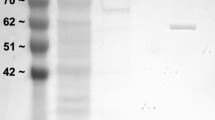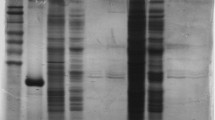Summary
-
1.
Isoelectrofocusing and cellulose acetate electrophoresis demonstrated the presence of three tissue specific isozymic forms of pyruvate kinase (PK) occurring in red muscle (ventricle, radula retractor), white muscle (foot, mantle) and soft tissues (gill, kidney, hepatopancreas) of the channelled whelk,Busycotypus canaliculatum.
-
2.
Under the assay conditions used the three isozymes differed kinetically with respect to fructose-1,6-bisphosphate activation: red muscle PK was insensitive, white muscle PK was slightly activated and soft tissue PK was strongly activated.
-
3.
Kinetic and physical properties of the enzyme in all tissues were modified when PK was isolated from whelks exposed to 21 h of anoxia stress. Compared to PK from aerobic tissues, the enzymes from anoxic animals showed a decrease in pI of 0.4 pH unit and an increase in anodal migration on cellulose acetate. Anoxia reduced the maximal activity of PK in all tissues and increased the activity ratios at high versus low phosphoenolpyruvate (PEP) concentrations. White muscle and soft tissue PK from anoxic whelks also showed increased activation by fructose-1,6-biphosphate compared to aerobic animals.
-
4.
Maximal activities and activity ratios at high versus low PEP for phosphoenolpyruvate carboxykinase (PEPCK) were not altered as a result of anoxia stress.
-
5.
The anoxia-induced in vivo modification of PK appears to be the result of enzyme phosphorylation during anoxia and this covalent modification is probably a major factor limiting PK activity during anoxia and promoting the carboxylation of PEP via PEPCK.
Similar content being viewed by others
Abbreviations
- IDP :
-
inosine diphosphate
- MES :
-
2-(N-morpholino)ethanesulfonic acid
- PEP :
-
phosphoenolpyruvate
- PEPCK :
-
phosphoenolpyruvate carboxykinase
- PK :
-
pyruvate kinase
- PMSF :
-
phenylmethylsulphonyl fluoride
References
Blair JB, Cimbals MA, James ME (1982) Hepatic pyruvate kinase. Quantitative measurements of phosphorylation in vitro and in the isolated rat hepatocyte. J Biol Chem 257:7595–7602
Ellington WR (1983) Phosphorus nuclear magnetic resonance studies on energy metabolism in molluscan tissues: Effect of anoxia and ischemia on the intracellular pH and high energy phosphates in the ventricle of the whelk,Busycon contrarium. J Comp Physiol 153:159–166
Engstrom L (1978) The regulation of liver pyruvate kinase by phosphorylation-dephosphorylation. In: Horecker B, Stadtman E (eds) Current topics in cellular regulation, vol. 13. Academic Press, New York, pp 29–51
Giles IG, Poat PC, Munday KA (1976) Purification and properties of pyruvate kinase from the crab,Carcinus maenas. Biochem J 153:127–134
Guderley HE, Hochachka PW (1977) Gluconeogenic control adaptations inCancer magister: Hypodermal pyruvate kinase, an enzyme with high- and low-affinity states. Arch Biochem Biophys 182:465–477
Guderley HE, Cardenas JM (1979) Developmental changes in pyruvate kinase isozymes of coho salmon. J Exp Zool 208:1–12
Guderley HE, Storey KB, Fields JHA, Hochachka PW (1976) Catalytic and regulatory properties of pyruvate kinase isozymes from octopus mantle muscle and liver. Can J Zool 54:863–870
Guderley HE, Fields JHA, Cardenas JM, Hochachka PW (1978) Pyruvate kinase isozymes from liver and kidney ofAraepima aisas. Can J Zool 56:852–859
Hochachka PW, Mustafa T (1972) Invertebrate facultative anaerobiosis. Science 178:1056–1060
Holwerda DA, de Zwaan A, van Marrewijk W (1973) The regulatory role of pyruvate kinase in the sea musselMytilus edulis L. Neth J Zool 23:225–228
Holwerda DA, Kruitwagen EC, De Bont AM (1981) Modulation of pyruvate kinase and phosphoenolpyruvate carboxykinase activity during anaerobiosis inMytilus edulis L. Mol Physiol 1:165–171
Holwerda DA, Veenhof PR, van Heugten HA, Zandee DI (1983) Regulation of mussel pyruvate kinase during anaerobiosis and in temperature acclimation by covalent modification. Mol Physiol 3:225–234
Holwerda DA, Veenhof PR, de Zwaan A (1984) Physiological and biochemical investigations of the ecological relevance of anaerobiosis in bivalves. I. The changes in activity of mussel adductor muscle and mantle pyruvate kinase during aerial exposure and reimmersion. Mar Biol Lett 5:185–190
Munday KA, Giles IG, Poat PC (1980) Review of the comparative biochemistry of pyruvate kinase. Comp Biochem Physiol 67B:403–411
Mustafa T, Hochachka PW (1971) Catalytic and regulatory properties of pyruvate kinases in tissues of a marine bivalve. J Biol Chem 246:3196–3203
Plaxton WC, Storey KB (1984b) Purification and properties of aerobic and anoxic forms of pyruvate kinase from red muscle tissue of the channelled whelk,Busycotypus canaliculatum. Eur J Biochem 143:257–265
Plaxton WC, Storey KB (1984b) Phosphorylation in vivo of red muscle pyruvate kinase from the channelled whelk,Busycotypus canaliculatum, in response to anoxic stress. Eur J Biochem 143:267–272
Schloen LH, Bamburg JR, Sallach HJ (1969) Isozymes of pyruvate kinase in tissues and eggs ofRana pipiens. Biochem Biophys Res Commun 36:823–829
Storey KB (1985) Kinetic and regulatory properties of pyruvate kinase isozymes from flight muscle and fat body of the cockroach,Periplaneta americana. J Comp Physiol B 155:339–345
Storey KB, Hochachka PW (1975) Squid muscle pyruvate kinase: control properties in a tissue with an active alphaglycerophosphate cycle. Comp Biochem Physiol 52B:187–192
Susor WA, Rutter WJ (1971) A method for the detection of pyruvate kinase, aldolase, and other pyridine nucleotide linked enzyme activities after electrophoresis. Anal Biochem 43:147–155
Vesterberg O (1971) Isoelectrofocusing of proteins. In: Colowick SP, Kaplan NO (eds) Methods in enzymology, vol. 22. Academic Press. New York, pp 389–412
Wijsman TC (1975) pH fluctuations inMytilus edulis L. in relation to shell movements under aerobic and anoxic conditions. In: Barnes H (ed) Proc 9th Eur Mar Biol Symp. Aberdeen Press, Aberdeen, pp 139–149
Zwaan A de (1972) Pyruvate kinase in muscle extracts of the sea musselMytilus edulis L. Comp Biochem Physiol 42B 7–14
Zwaan A de (1977) Anaerobic energy metabolism in bivalve molluscs. Oceanogr Mar Biol Annu Rev 15:103–187
Zwaan A de, Dando PR (1984) Phosphoenolpyruvate-pyruvate metabolism in bivalve molluscs. Mol Physiol 5:285–310
Author information
Authors and Affiliations
Rights and permissions
About this article
Cite this article
Plaxton, W.C., Storey, K.B. Tissue specific isozymes of pyruvate kinase in the channelled whelkBusycotypus canaliculatum: enzyme modification in response to environmental anoxia. J Comp Physiol B 155, 291–296 (1985). https://doi.org/10.1007/BF00687470
Accepted:
Issue Date:
DOI: https://doi.org/10.1007/BF00687470




